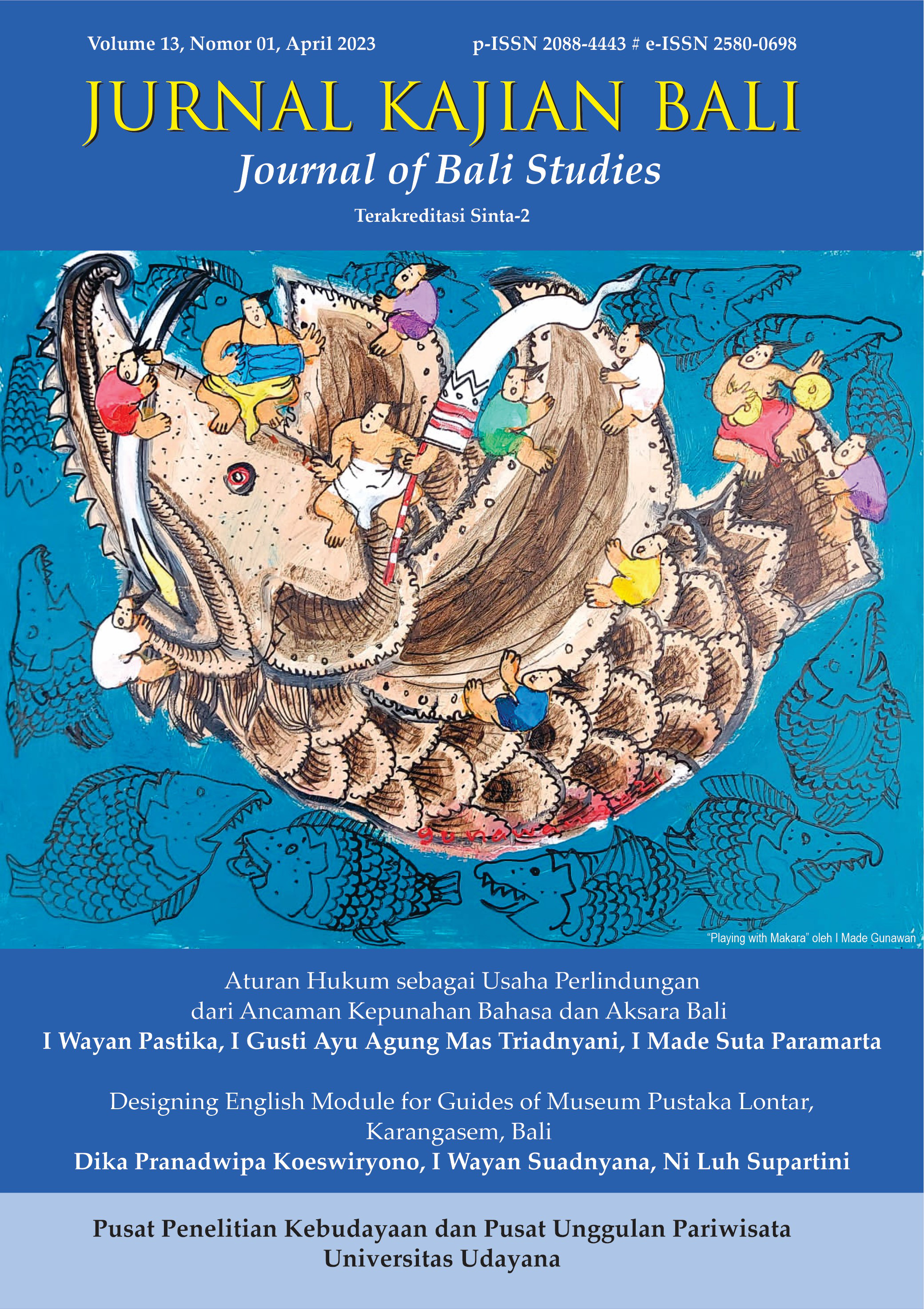Balinese Food Menu in Translation
Abstract
Translation plays an important role in transferring the data among languages. Thus, translation is not just about translating languages, but also exploring cultures. This can be seen from the translation of traditional Balinese food menus which used to present various names of special dishes as part of Balinese local wisdom. The translation of traditional Balinese food menus is interesting to study since there are no professional translators involved in making it and the emergence of various technical terms are not easy to translate. This research was conducted with a qualitative descriptive method to analyze data and determine the translation strategy by considering the aspects of ingredients, taste, size, process, and shape. The theoretical framework by Newmark (1988) was applied to examine the data. The results of the analysis show that the food menu translation strategy which includes expansion and descriptive equivalent are based on several aspects of food menu translation.
Downloads
References
Chiaro, D., Rossato, L. (2015). Food and translation, translation and food. The Translator, 21(3). 237-243.
Edmonds, I., Mikinac, K., Petrc, A.S. (2019). Strategic Approaches to Menu Translation Analysis. https://doi.org/10.20867/tosee.05.31.
Ghafarian, M., Kafipour, R., & Soori, A. (2016). Domestication and foreignisation strategies in restaurant menu translation. Pertanika Journal of Social Sciences and Humanities, 24(4), 1417–1429.
Goundar, S. (2012). Research Methodology and Research Method. Multiple Universities.
Hobart, M. (2022). Cultural Studies and Everyday Life: A Balinese Case. Jurnal Kajian Bali, Vol.2, No.2, 627 - 632
Jakobson, R. (2013). On linguistic aspects of translation. In On translation (pp. 232-239). Harvard University Press.
Johnson, M.T. (2013). What Is Culture? What Does It Do? What Should It Do. Northumbria University.
Li, S. (2018). A corpus-based multimodal approach to the translation of restaurant menus. Perspectives Studies in Translatology, 27(1), 1–19. https://doi.org/10.1080/0907676X.2018.1483408
Loescher, W. (1991). Translation performance, Translation Process and Translation Strategies. Tuebingen.
Mahmud, E. Z. (2022). The Translation of the Most Popular Indonesian Food into English in Novels. International Journal of Social Science And Human Research, Volume 05 Issue 02 February 2022. 543-550.
Newmark, P. (1988). Textbook of Translation. Prentice Hall International.
Nord, C. (2005). Text Analysis in Translation: Theory, Methodology, and Didactic Application of a Model for Translation-Oriented Text Analysis. Editions Rodopi B.V.
Oxford Learner’s Dictionaries. (2022). Definition of Chargrill. Oxford University Press.
Plonska, D. (2014). Strategies of Translation. IT University of Copenhagen.
Rasna, W., Tantra, D. K., Wisudariani, N. M. R. (2016). Harmonisasi Kearifan Lokal Nusantara dan Bali Untuk Pendidikan Karakter di Sekolah Dasar: Sebuah Analisis Etno-Pedagogi. Jurnal Kajian Bali, Vol. 6, No. 1, 275-290
Santrock, J. W. (1998). Adolescence. McGraw-Hill Humanities, Social Sciences & World Languages.
Setyaningsih, R.W. (2020). Food Name Translation Practice: A Case Study of Indonesian–English Menus. NOTION: Journal of Linguistics, Literature, and Culture, Vol. 2, No. 2, 124-130.
Tanudirjo, R. (2020). The English Translation of Food Menu in Three Restaurants in Yogyakarta: The Acceptability and Strategies. Universitas Sanata Dharma Yogyakarta.
Volkova, T. (2014). Translation model, translation analysis, translation strategy: an integrated methodology. Procedia-Social and Behavioral Sciences. Elsevier.

This work is licensed under a Creative Commons Attribution 4.0 International License.



















